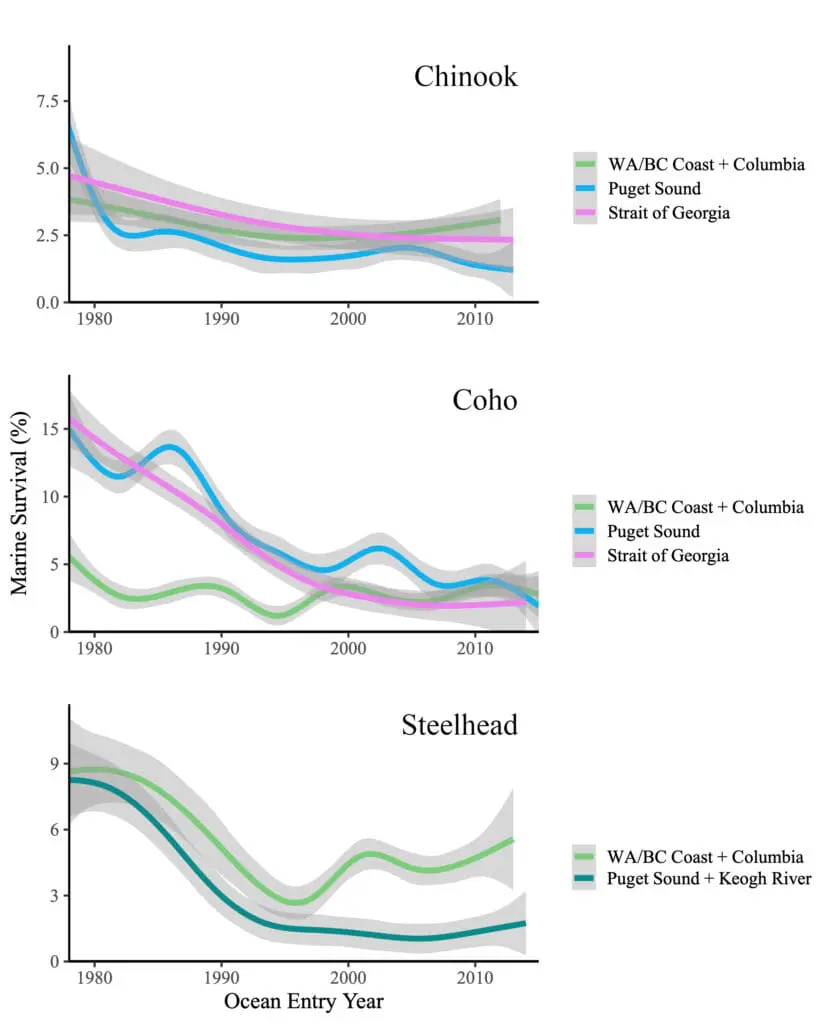Why are salmon dying in the Salish Sea?
The Salish Sea Marine Survival Project (SSMSP) united U.S. and Canadian researchers to determine why juvenile Chinook, coho, and steelhead are dying in the shared waters of Puget Sound and the Strait of Georgia, collectively known as the Salish Sea.
From 2014 to 2021, Long Live the Kings, in partnership with the Pacific Salmon Foundation of Canada, coordinated more than 60 organizations in a holistic study of the physical, chemical, and biological factors impacting salmon and steelhead survival. In 2021, the SSMSP published a Synthesis Report summarizing key findings from dozens of studies. This project has become a model for ecosystem-scale collaborative science. With the completion of the main research phase, the SSMSP continues as LLTK and our partners on both sides of the border pursue further studies and pilot solutions to facilitate smarter management and stronger returns.

Populations in Decline
The marine survival of Chinook and coho salmon and steelhead populations in the Salish Sea have declined by up to 90%, and their abundance remains well below what it was 40 years ago. This is despite considerable investments in hatchery and harvest reform and in habitat protection and restoration.
Salmon populations in coastal rivers have not shown the same declines, suggesting that the problem lies with factors within the Salish Sea—the combined waters of Puget Sound and the Strait of Georgia. The loss of salmon threatens the heart of Pacific Northwest culture, the health of our local sea, a multi-billion-dollar fishing industry, and deeply rooted Native American traditions and treaty rights.

Working Together to Benefit Salmon
Established in 2014 by Long Live the Kings and the Pacific Salmon Foundation, the Salish Sea Marine Survival Project brought together an international team of scientists and managers from dozens of federal, state, tribal, academic, private, and nonprofit organizations to determine why juvenile salmon and steelhead are dying in the Salish Sea.
During the research phase, more than 200 researchers assessed young salmon and steelhead growth, health, and diet; tracked fish and marine mammal movements; monitored marine conditions; and developed innovative technologies to answer critical questions facing salmon recovery and sustainable fisheries. With the publication of the Synthesis Report in 2021, we are moving forward to put this science into action.
Study results and new tools are being used to implement real-world actions that improve hatchery, harvest, and ecosystem management and inform habitat protection and restoration. Along the way, we are ensuring that the findings of this comprehensive ecological effort broadly inform Salish Sea ecosystem recovery—from forage fish to birds to our threatened orca whales.
The Salish Sea Marine Survival Project has also stimulated interest in communication among salmon and ocean ecology researchers across the region. Around the Salish Sea, monitoring programs continue to collect and share data on ocean conditions that drive crucial food web dynamics, especially as climate change alters their patterns. In 2023, researchers and partners from the SSMSP came together again to discuss new research, progress on the SSMSP’s goals, and identify a path to continue this important work into the future. Further information on this workshop can be found below:
Projects Created from the SSMSP